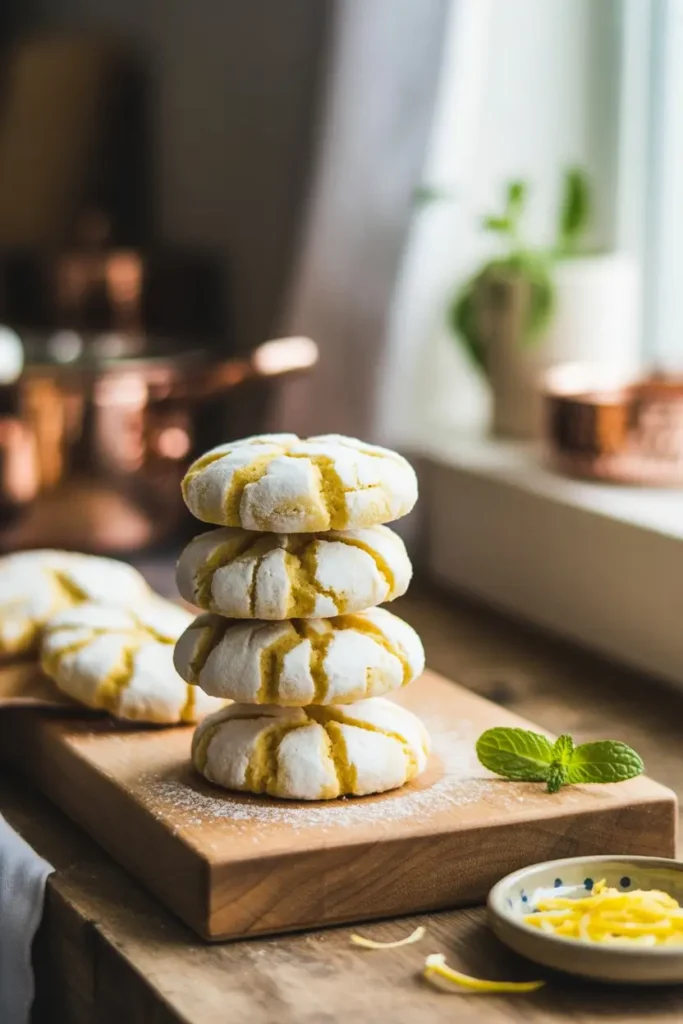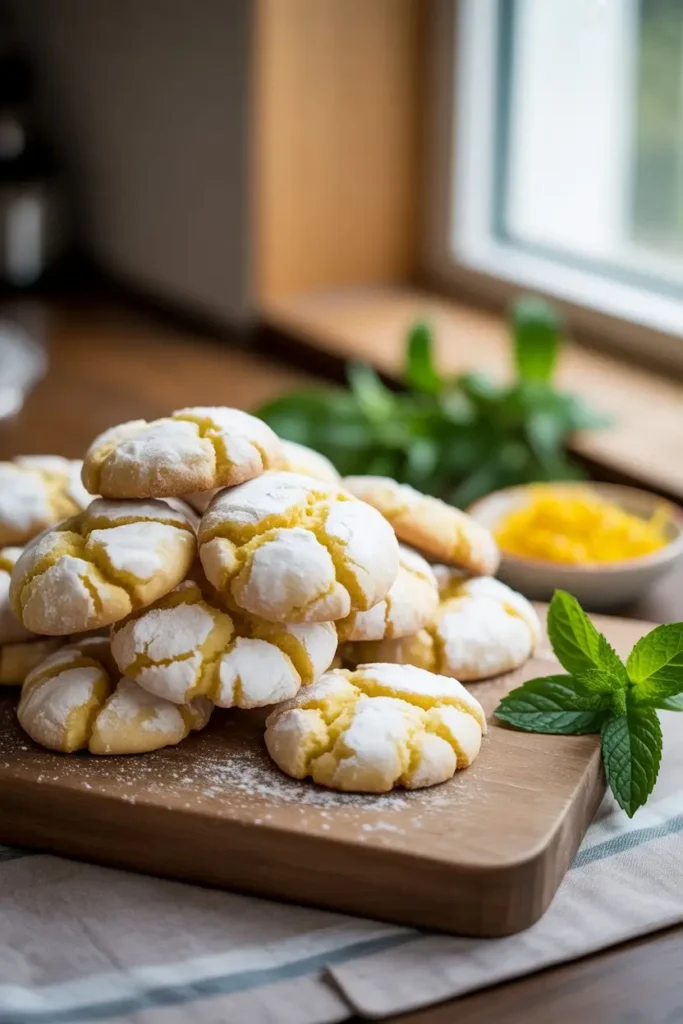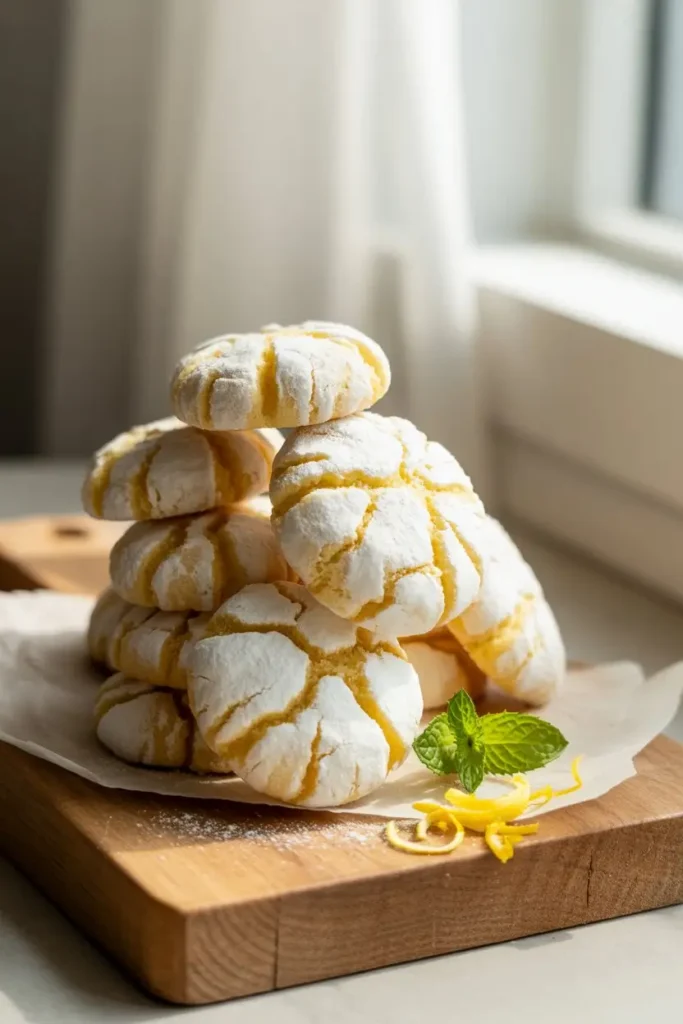Craving lemon crinkle cookies that hit that perfect balance of bright citrus and soft, chewy centers? You’re in the right place.
Introduction
If most of lemon’s aromatic compounds live in the zest according to food science research, why do so many home-baked cookies lean sugary instead of tangy? The answer sits in your technique and a few strategic ingredients.
Here’s a method designed for big citrus payoff with consistent crinkles. The plan: build flavor with zest, balance acidity and sweetness, and keep dough temperature in the driver’s seat so the tops split into those picture-perfect ridges. You’ll get the classic crackly, powdered sugar finish with a center that stays plush for days.
Expect a result that tastes like spring, with fragrance that actually survives the oven.
Ingredients List
This mix prioritizes lemon oils, gentle structure, and reliable crinkles. Use the substitutions to tailor for your pantry or preferences.
- 1 3/4 cups (210 g) all-purpose flour
- 2 teaspoons cornstarch for tenderness
- 1/2 teaspoon baking powder
- 1/4 teaspoon baking soda for lift and crinkle spread
- 1/4 teaspoon fine sea salt
- 1/2 cup (113 g) unsalted butter, softened to cool room temperature
- 3/4 cup (150 g) granulated sugar
- 1 large egg, room temperature
- 1 large egg yolk, room temperature
- 2 tablespoons finely grated lemon zest, packed (from 2 to 3 lemons)
- 2 tablespoons fresh lemon juice
- 1 teaspoon pure vanilla extract
- 1/2 teaspoon lemon extract for extra punch, optional but effective
- 1/4 cup (50 g) granulated sugar for rolling
- 1/2 cup (60 g) powdered sugar for rolling
Substitutions and smart swaps:
- Gluten-free: Use a 1:1 gluten-free baking blend. If it contains xanthan, keep the recipe as written. If not, add 1/4 teaspoon xanthan gum.
- Dairy-free: Swap butter for a quality plant butter stick with at least 75 percent fat. Avoid tub spreads.
- Egg-free: Use 1 flax egg for the whole egg (1 tablespoon ground flax + 3 tablespoons water, rested 10 minutes) and 1 tablespoon aquafaba to stand in for the yolk.
- Brighter lemon: Replace vanilla with 1 teaspoon limoncello or add 1/4 teaspoon citric acid to the dry ingredients for a sharper tang.
- Softer crumb: Replace 2 tablespoons butter with 2 tablespoons full-fat cream cheese; the mild tang and water content improve tenderness.
- Less refined sugar: Use organic cane sugar in the dough and a natural powdered sugar for rolling. Expect slightly less opaque crinkles.
Sensory cue: Zest should feel fluffy and damp with oils. If it looks dry or pithy, you’re not getting maximum aroma.

Timing
- Prep time: 20 minutes
- Chill time: 30 minutes
- Bake time: 10 to 12 minutes per sheet
- Total time: About 75 minutes for the first batch, which is roughly 20 percent faster than many recipes that suggest a 2-hour chill
Batching note: Chilling only 30 minutes gives defined crinkles while making production faster. If your kitchen runs warm, stretch the chill to 45 minutes.
Step-by-Step Instructions
Step 1: Preheat and pan prep
Set the oven to 350°F (175°C). Line two baking sheets with parchment or silicone mats.
- Tip: An oven thermometer often shows home ovens run 10 to 25 degrees off. If tops brown too fast or don’t crinkle, temperature is usually the culprit.
Step 2: Zest the lemons with intent
Finely zest 2 to 3 lemons directly into your sugar bowl. Use short strokes to avoid the white pith.
- Tip: Pinch the sugar and zest together for 30 seconds. This “sugar massage” releases citrus oils, boosting aroma without extra extract.
Step 3: Cream for a light, not fluffy, base
In a stand mixer bowl, beat butter and the lemon sugar on medium speed for 2 minutes until pale and slightly increased in volume. Scrape the bowl. Add egg, yolk, vanilla, and lemon extract if using. Beat 30 seconds more until glossy.
- Tip: Over-creaming whips in too much air, which reduces crinkles. Aim for light and cohesive, not pillowy.
Step 4: Combine dry ingredients with precision
Whisk flour, cornstarch, baking powder, baking soda, and salt in a separate bowl. Add the dry mix to the wet on low speed in two additions. Pour in lemon juice last and mix just until no dry streaks remain.
- Tip: Adding juice at the end minimizes gluten activation and keeps texture tender.
Step 5: Chill for control
Cover and chill the dough for 30 minutes. This firms the fats so cookies spread in the oven at the right pace.
- Tip: Warm kitchen or soft butter? Chill 45 minutes. Cold kitchen or firm butter? You can go as short as 20 minutes.
Step 6: Roll, double-coat, and set on trays
Place the rolling sugars in two shallow bowls. Scoop dough into 1 1/2 tablespoon portions, then roll each ball first in granulated sugar, then in a heavy coating of powdered sugar. Space 2 inches apart on prepared trays.
- Tip: The granulated sugar layer acts as a moisture barrier, keeping the powdered sugar snowy white.
Step 7: Bake for crinkles with soft centers
Bake one sheet at a time for 10 to 12 minutes until edges look just set and tops are deeply cracked. Centers should look slightly underdone.
- Visual cue: If you gently nudge a cookie, it should hold shape yet feel soft. That carryover heat finishes the bake.
Step 8: Cool with care
Let cookies rest on the sheet for 5 minutes, then move to a rack to cool completely.
- Tip: Don’t shake excess sugar off during cooling. It fuses into that signature crust.
Batching: If you rolled more than one sheet, keep waiting dough in the fridge to maintain consistent crinkles.

Nutritional Information
The following is an estimate for one cookie when the batch yields 24 cookies. Actual values vary with ingredient brands and coating thickness.
| Nutrient | Per Cookie (approx.) |
|---|---|
| Calories | 115 |
| Total Fat | 4 g |
| Saturated Fat | 2.5 g |
| Carbohydrates | 18 g |
| Total Sugars | 11 g |
| Protein | 1 g |
| Sodium | 50 mg |
| Fiber | 0.3 g |
Data tip: Powdered sugar losses during rolling mean some coating stays on the tray. The table reflects typical adherence, not the full bowlful.
Healthier Alternatives for the Recipe
- Swap part of the flour: Use 1 cup all-purpose plus 3/4 cup white whole wheat or whole wheat pastry flour for more fiber with mild flavor impact.
- Cut added sugar: Reduce the dough sugar to 2/3 cup and the powdered sugar to 1/3 cup. Expect a more lemon-forward, slightly less glossy finish.
- Add protein and softness: Replace 2 tablespoons butter with 2 tablespoons Greek yogurt. Whisk smooth before adding.
- Dial up lemon without extra sugar: Add 1/4 teaspoon citric acid to the dry mix for a sharper flavor that doesn’t rely on sweetness.
- Dairy-free path: Plant butter sticks and aquafaba support structure while keeping the crumb tender.
- Gluten-free consistency: Chill the dough a full 45 minutes and keep portions small. This supports spread and crinkle development without gluten.
Flavor add-ons that keep nutrition in line:
- Poppy seeds, 1 tablespoon, for a subtle crunch and classic pairing
- Blueberry powder, 2 teaspoons, for color contrast and natural fruit notes
- Fresh thyme leaves, 1 teaspoon, for a light herbal accent that reads sophisticated
Serving Suggestions
- Afternoon tea plate: Pair with Earl Grey or jasmine tea. The bergamot or floral notes make the lemon pop.
- Citrus sandwich: Spread a thin layer of lemon curd between two cookies. Chill 15 minutes to set.
- Brunch board: Set cookies alongside fresh berries, ricotta, and a small bowl of honey. Let guests mix sweet and tart.
- Frozen treat: Crumble cookies over vanilla frozen yogurt or lemon sorbet for texture and punch.
- Party platter contrast: Mix with chocolate crinkles for a striking black-and-yellow look.
Personal tip: Warm a single cookie in the microwave for 6 to 8 seconds. The center turns plush and the aroma blooms like it’s fresh from the oven.
Common Mistakes to Avoid
- Using bottled lemon juice: Heat can flatten bottled juice flavor. Fresh zest and juice deliver brighter results.
- Skipping the sugar massage: Rubbing zest into sugar extracts oils efficiently. This small step boosts aroma more than extra extract.
- Overmixing after flour: Stir only to combine. Extra mixing tightens gluten and dulls the tender bite.
- Not chilling: Warm dough spreads too quickly and won’t form clean crinkles. Even a short chill sets you up for success.
- Undercoating with powdered sugar: A thin layer melts and turns patchy. Aim for full, even coverage.
- Overbaking: Brown edges signal a drier, cake-like texture. Pull when edges are set but pale.
- Crowded pans: Tight spacing traps steam and softens the crust. Give each cookie breathing room.
- Temperature drift: Ovens cycle. Bake one sheet at a time, center rack, and wait for the preheat light to return between batches if your oven swings.
Insight: Home ovens often vary by 15 degrees or more. An inexpensive thermometer pays off with consistent crinkles and even color.
Storing Tips for the Recipe
- Room temperature: Store in an airtight container for 3 to 4 days. Add a small piece of bread to regulate humidity if your climate is dry.
- Freeze baked cookies: Layer with parchment in a sealed container or bag for up to 2 months. Thaw at room temp, then revive with a 2-minute rest in a 300°F oven for a just-baked feel.
- Freeze dough: Scoop and roll into balls, chill until firm, then freeze up to 2 months. Roll in sugars just before baking. Add 1 extra minute to bake time if going straight from frozen.
- Keep the coating bright: Only roll in powdered sugar right before baking. Pre-coated frozen balls absorb moisture and dull the finish.
Make-ahead note: Zest lemons when you buy them, keep zest packed with sugar in a sealed jar, and store in the freezer. You’ll have citrus-scented sugar ready for quick batches.
Conclusion
Bright citrus starts with zest, balanced sweetness, and a chill that keeps the crinkle clean. You now have a step-by-step plan that produces soft, tangy cookies with a snowy finish, every time. Bake a batch, share how it goes in the comments or reviews, and subscribe to get more practical bakes you’ll want on repeat.
FAQs
Can I use Meyer lemons?
Yes. Meyer lemons taste sweeter and less acidic, so the cookie will read softer and floral. Consider adding 1/8 teaspoon citric acid or a splash of regular lemon juice to sharpen the flavor.
Do I really need both baking powder and baking soda?
The combo controls lift and spread. Baking soda reacts with lemon juice for early rise and cracking. Baking powder sustains lift so the crinkles hold instead of collapsing.
My powdered sugar melted. What happened?
Two common causes: thin coating or warm dough. Roll generously in granulated sugar, then powdered sugar, and chill the remaining dough between batches.
Can I skip the chill?
Not recommended. Without a short chill, the cookies spread too fast and lose definition. If pressed for time, pop the tray of rolled balls into the freezer for 10 minutes instead.
How do I make bigger cookies?
Use 3 tablespoons dough per cookie and bake 12 to 13 minutes. The centers stay soft but need an extra minute. Keep spacing wide, at least 3 inches.
What about high altitude?
Reduce baking powder to 1/4 teaspoon and bake at 365°F. Add a tablespoon of flour if the dough looks slack. Watch early, since edges set quicker.
Can I cut the sugar more?
You can take the dough sugar down to 2/3 cup and still get a soft cookie. Reduce powdered sugar to 1/3 cup for the coating. Expect less opacity but balanced flavor.
Is lemon extract necessary?
Not required. The zest does most of the heavy lifting for aroma. If you want a stronger lemon note without extra juice, extract provides a clean boost.
How do I know when to pull them?
Look for deep cracks, pale edges, and a soft middle that barely holds a gentle poke. If the bottoms are browning, you’ve gone too far.
Any tools that make a difference?
- Microplane-style zester for ultrafine zest without pith
- #40 cookie scoop for consistent size and even baking
- Oven thermometer for accuracy
- Parchment sheets to keep bottoms light and prevent overbrowning
Curious about more citrus bakes or chocolate crinkle variations? Tell me what you’d like next, and we’ll build it into an upcoming post.


